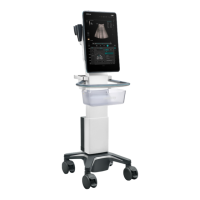6 - 16 Operator’s Manual
6 Image Acquisition
Tissue State
This function is used for fast image optimization.
6.8.3 TDI Quantitative Analysis
TDI is provided for reference, not for confirming a diagnosis.
To perform the strain and strain curve, the ECG curve is in need in case of the deviation in curve.
• The current image (in frozen state) and the saved image can be used in the quantitative
analysis.
• Only after the user chooses the image review, the quantitative analysis is available.If the user
chooses the static image (only one frame), the quantitative analysis is not available.
It is about analyzing the data of TVI imaging and measuring the velocity of the myocardium with
the cardiac cycle.
Here are three types of curves to perform the quantitative analysis:
• Velocity-time curve
• Strain-time curve
• Strain rate-time curve
– Strain: Deformation and displacement of the tissue within the specified time.
– Strain rate: speed of the deformation, as myocardial variability will result in velocity
gradient, strain rate is used commonly to evaluate how fast the tissue is deforming.

